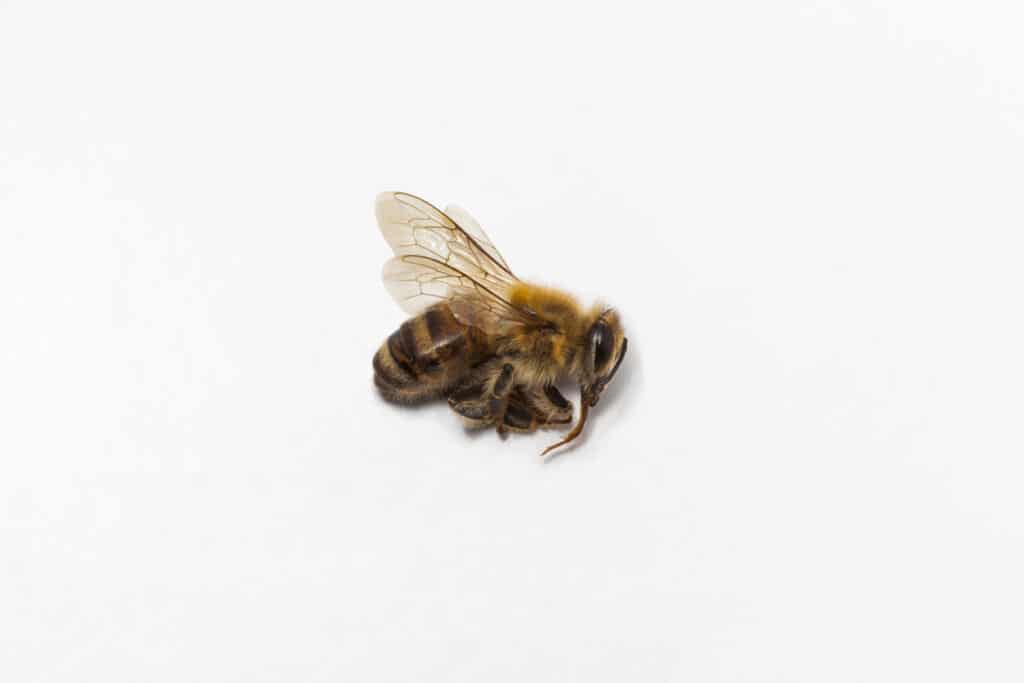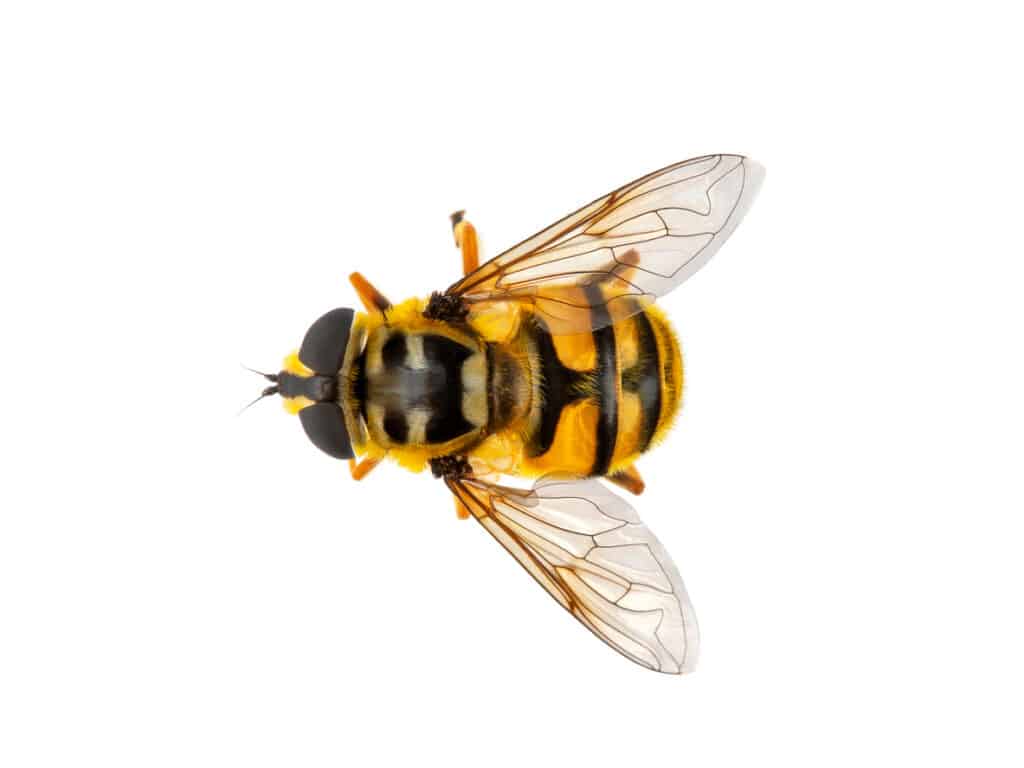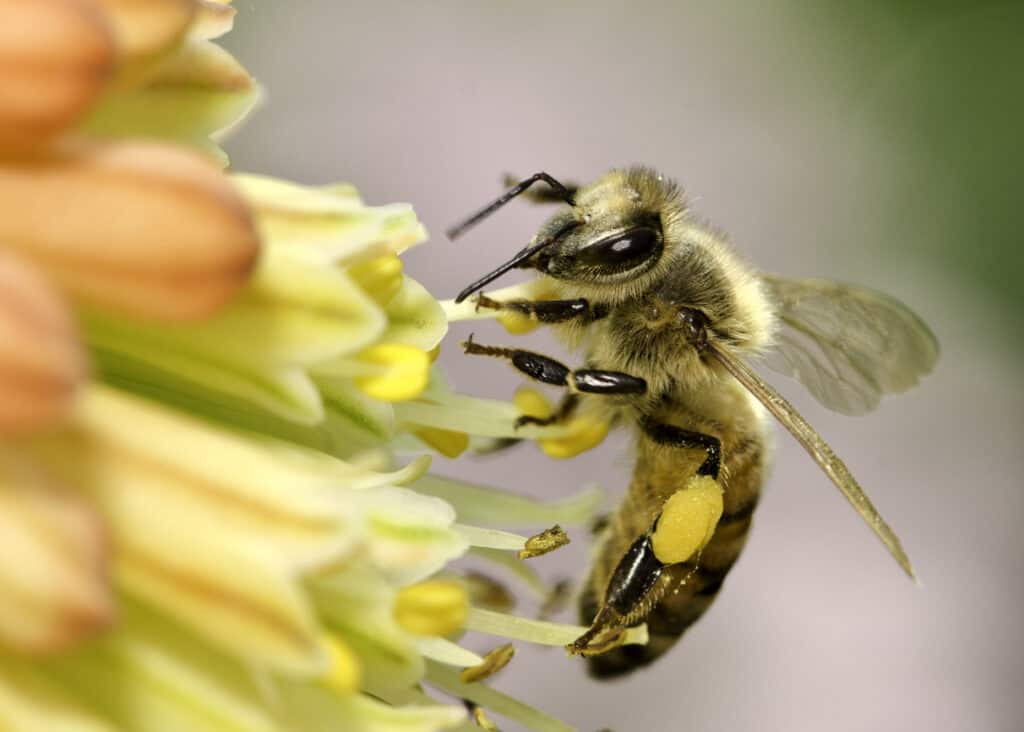Although revered for their crucial ecological work, bees cause a great deal of fear. Their stings can pack a punch, and if you are allergic to them, they could cause severe anaphylaxis. You may have heard bees die after they sting, but is this true for all bees?
Most female bees can sting. They have modified, barbed ovipositors that can lay eggs and deliver venom. Male bees cannot sting at all. Bees can sting other insects and thin-skinned mammals without dying. Not all species die after they sting; some have smooth stingers and can survive as a result.
There are many reasons to fear being stung by a bee. One reason is that you could unwittingly cause the death of an insect trying to defend its hive. It is likely a relief to know that not all bees sting, and of those that do, not all will die after they sting. Let’s buzz into the information hive and unpack bees, their stingers, and venom, and learn what happens after they sting.
Do All Bees Die After They Sting?

The short answer to the question: “Do all bees die after they sting?” is no. Not all bees die after they sting. The fact is that not all bees have the ability to sting, and some that have stingers are unable to effectively deploy them.
Furthermore, not all bees are unable to withdraw their stingers. If a bee can retrieve its stinger after delivering venom, it will be able to survive.
According to Arvin Pierce of Acbees Apiaries, not all honey bees need to die after stinging. He demonstrates how, if you give bees a little time, they can often twist and turn, use their hind legs and work themselves free of your skin without leaving a part of their body behind. It can take between twenty to ninety seconds, but bees would rather survive the encounter in most cases.
To fully understand the world of bees’ stings and which bees die after stinging, we should start with an understanding of what a bee stinger looks like. While we are here, let us also look at types of bees and which of those species sting.
Which Bee Species Sting?

There are several bee species, and not all of them sting. Let us look at a few types of bees and ascertain which sting. While looking at these details, let us also discuss the kind of stinger each mentioned bee has. In that way, we will see which bees die after stinging and which are likely to survive.
Honey Bees

The most widely known stinging species is the honey bee. The stinger of the honeybee is barbed and long. Honey bees typically sting to protect themselves or their hive. Honey bees often recruit other hive members when attacking. This practice helps ensure that the hive is protected and the threat is neutralized.
Because of the barbed stinger of the honey bee, it typically dies after stinging large mammals like human beings.
Africanized Honey Bees
Africanized honey bees, also known as Africanized killer bees, are a particularly aggressive species of bee. They look remarkably similar to regular honey bees but possess a few key differences. They swarm in large numbers and deliver painful stings.
Like common honey bees, Africanized honey bees have barbed stingers that often become lodged in the skin of their target. The barbed stinger of this bee will likely result in its death after stinging.
Bumble Bees
Although they look soft and cuddly, a bumble bee can sting you. Bumble bees are not generally aggressive, but if you are stung by one, it will hurt similarly to a honey bee sting.
Bumble bees’ stingers are not barbed. That means they can withdraw their stingers and continue living after stinging you or smaller prey.
Carpenter Bees
Carpenter bees can sting. An interesting point to note about this type of bee is that it is typically the males that appear to attack as they investigate movement.
They protect their territory in this way. Rest assured, though, that male carpenter bees cannot sting since they do not have ovipositors that females possess.
Carpenter bees’ stingers are not barbed. That means they can withdraw their stingers after delivering venom to your skin and continue living.
Stingless Bees (Meliponini)
Certain bees cannot sting. These belong to the tribe “Meliponini .” These bees may not sting, but they do bite, so they should also be treated with care.
Many of these bees have stingers, though they are too small to deliver venom to prey or enemies.
A few Meliponini bees include:
- Trigona
- Heterotrigona
- Plebeian
- Partamona
There are a great many Meliponini bees, and they are scattered around Australia, Africa, South East Asia, and tropical America.
Solitary Bees
There is another group of bees called Solitary bees. About two hundred different types of solitary bees make up around ninety percent of the world’s bee population. Solitary has no queen or hive and does not make honey.
Solitary bees are less likely to sting since they do not have a hive to defend. Those that are solitary and able to sting will sting if prompted or threatened.
Did you know? Solitary bees are under threat. There is a week to celebrate solitary bees. It typically occurs in June and July. You can learn more about showing love and protection for solitary bees here.
What Does A Bee Stinger Look Like?
A bee’s stinger looks a little like a sewing needle attached to a sack. The longest part of the stinger is slightly curved and barbed in the case of honey bees. There is an enlarged section closest to the bee’s body. This is where you should insert something sharp to remove the stinger if you get stung.
Inside the body of the bee, there is a venom sack. This sack contains venom and muscle for pumping the venom out.
It is remarkable to see a bee stinger up close. Several working parts enable the bee to sting and release venom effectively. Let us go a little closer and see how the stinger works on a microscopic level.
The stinger itself has a stabilizing rod and two serrated digging blades. The blades move up and down alternately, helping the stinger lodge into the skin. This action also helps the venom be released in an ongoing fashion.
The muscles below the venom sack contract in a pumping motion. This action squeezes the venom pump, releasing venom into the stinger.
When a stinger is left behind after a bee has stung, it is interesting to see the venom sack and possibly some other insides that may have been stuck on your skin. Removing the stinger from your skin as quickly as possible is essential. Even after the bee has flown away, the venom sack will continue pumping for about two and a half minutes.
Remove the sting and venom sack from your skin to avoid much pain and possible complications from having more venom in your system than is completely necessary.
Why Do Bees Die After They Sting?
Before we get into why bees die after they sting, we must understand that not all bees die after they sting. Indeed, only certain bees can sting. It is uniquely the female of the species that can sting. Their stinger is a modified ovipositor, typically used to lay eggs. Male bees do not have ovipositors and so cannot sting.
The stinger of most bees is designed with barbs. When a bee stings an insect prey or small animal with thin skin, it can pull the stinger out and continue living.
When a bee stings a large mammal, like a human being, the barbed stinger becomes lodged in the skin. The bee is not strong enough to pull it out. The stinger remains in the mammal’s skin as the bee flies away. The bee rips off the back part of her body. She is disemboweled and dies within minutes.
Often, the venom sack remains on the skin with the stinger. In this case, you need to remove it as quickly as possible. Not only will the sack continue to release venom into your skin, but the scent will attract other bees to continue the attack in defense of the hive.
It is important to note that if the bee can withdraw its stinger from your skin, it will not die after stinging you.
How Long Do Honey Bees Live After Stinging?
If a honey bee has stung you and cannot retrieve its stinger, it will die. The unfortunate truth is that by leaving the stinger behind, the bee breaks off the back part of its body as it flies away.
Honey bees have been observed to live for a few minutes or a few hours after losing their stingers. It depends on the individual, though the process does inevitably kill them.
If a honey bee is allowed to try and free itself from your skin, it may be fortunate enough to keep its stinger and fly away to live another day. Honey bees have been witnessed to free themselves within twenty to ninety seconds. They turn clockwise and anti-clockwise and use their hind legs to free themselves.
If you see a bee trailing liquid from its behind, know that it has likely lost its sting and will soon die. You can choose to put the bee out of its misery or make it comfortable in its last minutes or hours.
The venom sack left behind after the stinger has been lodged into your skin will continue pumping for around two and a half minutes. This timeframe is not an indication of how long the bee has lived but instead of the amount of venom capable of being pumped into your skin.
Do Queen Bees Die After They Sting?
Queen bees can and do sting. Their advantage is that their stinger is not barbed like the worker bees’ stingers. Queen bees can sting multiple times, retract their stinger and continue their life.
It is particularly rare for a queen bee to sting a human. On such a rare occasion, the sting is not as painful as a worker honey bee. This is likely because queen bees are not designed to use their stingers on human beings.
Queen bees typically use their stingers to attack other queens. They defend their territory from other queens in a fight to the death. Their stinger is their primary weapon, and they will use it on mature and developing queens.
Developing queens are still in the pupae stage and are encased in queen cells. Active queen bees will insert their stingers through the case and kill the pupae before they have the opportunity to mature.
Conclusion
Thankfully, not all bees die after they sting. When bees sting other insects or prey with non-elastic skin, they can retrieve their stingers and continue living. Honey bees and Africanized honey bees have barbed stingers. Their barbed stingers are what cause their death, as they become lodged in our skin and cause the bee to lose the back of its body as it attempts to fly away.
Most bee species have stingers that are not barbed. This means they can sting and fly away. Queen bees have stingers that are not barbed, and they rarely sting human beings. Certain bee species do not sting at all. Only female bees can sting since their stingers are modified ovipositors. If you give a honey bee the opportunity to free herself, she will likely manage after about a minute and continue living.
Resources
https://www.terminix.com/blog/science-nature/do-bees-die-after-stinging/
https://en.wikipedia.org/wiki/Bee_sting
https://www.orkin.com/pests/stinging-pests/bees/bee-sting-facts-and-information
https://www.greenandblue.co.uk/blogs/news/5-things-you-need-to-know-about-solitary-bees
https://www.solitarybeeweek.com/
https://www.statedclearly.com/articles/evidence-for-evolution-in-your-own-backyard/https://wildflowermeadows.com/2020/01/can-queen-bees-sting/#:~:text=Given%20that%20a%20queen%20bee’s,in%20the%20process%20of%20stinging

